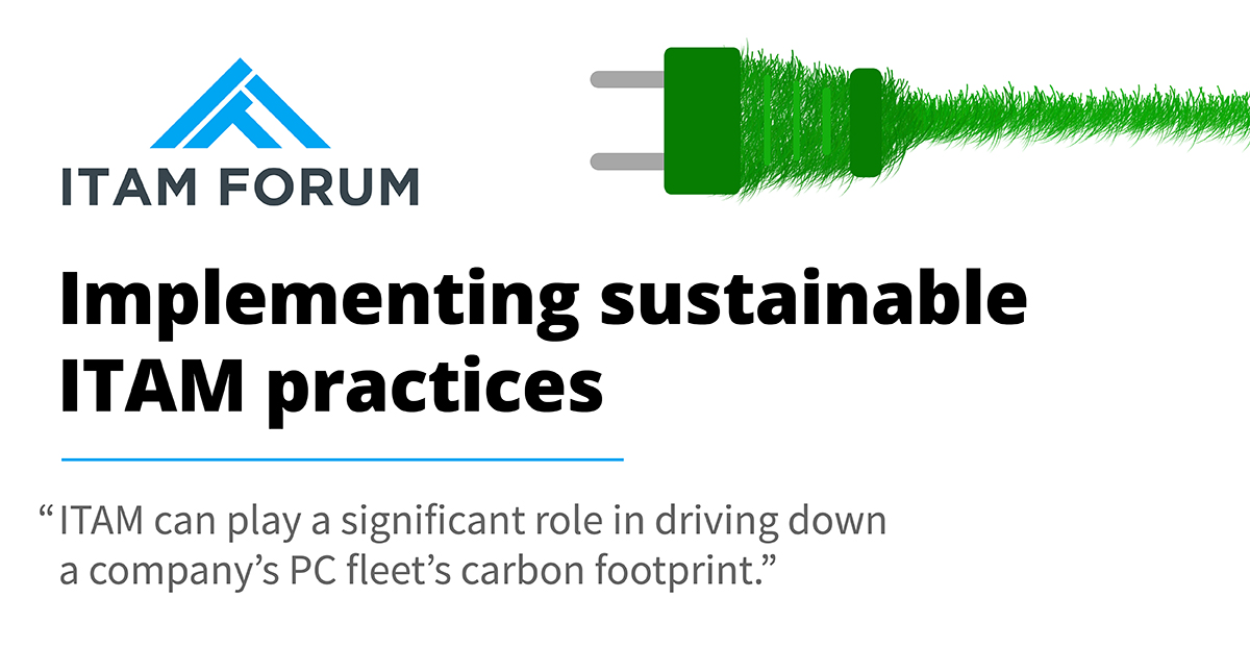Author: Jaroslaw Richert
ITAM Forum Trustee; Senior Management – IT Asset Governance, Schneider Electric
This article is the perfect read for ITAM practitioners looking to improve their ITAM practices, especially within sustainability. The data within showcases the ITAM practices and advice in improving your sustainability approaches.
Indeed by incorporating environmental and sustainability criteria into IT Asset Management, Schneider Electric has demonstrated how companies can unlock additional potential to reduce greenhouse gas (GHG) emissions within its internal IT.
IT Asset Management —overseeing an organization’s investment in IT, with its knowledge of the IT estate, usage, configurations and business value — has a pivotal role in delivering sustainable IT.
Environmental criteria has been gradually embedded into Schneider Electric’s IT Asset Management practices (with a strong focus on standardization and circular economy enablement). By doing so, they can create a holistic approach to sustainability throughout the entire lifecycle of IT assets.
Schneider Electric’s Carbon pledge for 2030 includes becoming carbon neutral in its operations through Scope 1 (direct GHG emissions) and Scope 2 (indirect GHG emissions) emission reductions and a 35% reduction in Scope 3 (other indirect GHG emissions) emissions.
A holistic, data driven ITAM approach
Meanwhile, in 2015 the International Telecommunication Union (ITU) estimated the carbon footprint of the Information Communication Technology (ICT) sector at approximately 740Mt CO2. Or approximately 3% of global carbon emissions. Electricity consumption of the ICT sector could be in the range of 969 TWh, or 3.9% of total electricity demand.
However, there’s a theory that global IT-related electricity demand is to account for 1,900TWh. Or 8% of total electricity demand with a potential to grow by 50% by 2030.
In conclusion, a holistic, data-driven ITAM approach has been taken to quantify the carbon footprint and energy consumption reduction/avoidance of Schneider Electrics’ PC fleet, monitoring each asset throughout its lifecycle.
Some of our results to date are as follows:
- Consolidating and adjusting the PC replacement lifecycle created a yearly weighted PC carbon footprint reduction of more than 15%.
- Shifting demand to standardized PC models has resulted in an estimated 1,000 tons of avoided CO2 /year.
- Setting ultra-small form factors as the default PC enclosure choice has resulted in further CO2 avoidance of more than 1,500 tons per year.
- Giving preference to Responsible Recycling (R2) or e-Steward compliant IT Asset Disposition vendors, leasing services, donations, and an Employee Purchase Scheme. As a result, a structured approach gives a second life for retired PCs. Extending a PC’s lifespan decreases the weighted yearly carbon footprint in the range of 50% through the amortization of embedded CO2 emissions over extended time.
Findings with our Implementing Sustainability ITAM Practices for Enterprise-wide Carbon Reduction:
The aim of our Implementing Sustainable IT Asset Management Practices for Enterprise-wide Carbon Reduction white paper is to encourage and help IT Managers to take a structured Green House Gas (GHG) protocol-aligned approach towards sustainability by leveraging ITAM practices to manage business PCs and other IT hardware assets.
The data-driven approach allows you to calculate the embodied and usage-related carbon footprint of an enterprise-level PC fleet in accordance with enterprise-wide GHG emission reduction efforts. The highly-granular nature of the data enables companies to monitor trends and provides insight into carbon emissions.
Furthermore, embedding environmental and sustainability criteria into each stage of the IT asset life cycle acts as a structured, cost-effective approach to optimize a PC fleet’s carbon footprint.
Some of the good practices described in the white paper include:
- Harmonize and adjust the PC replacement lifecycle from a sustainability perspective. This may result in the decrease of yearly weighted PC Carbon Footprint in the range of 10-20%.
- Use standardization as a sustainability vehicle. It is well known that PC standardization positively influences cost efficiencies, simplifies maintenance and support, and reduces risk. However, standardization could stream demand toward devices with reduced carbon footprints and high-energy efficiency. This can therefore, contribute to significant carbon footprint avoidance.
- Include in PC selection criteria sustainability factors like repairability level, energy consumption and overall carbon footprint. PCs with similar performances may differ significantly in terms of energy consumption and device carbon footprint. Therefore, having PC Carbon Footprint as a selection criteria enables organizations to standardize models with a lower GHG emission footprint.
- PCs with a high repairability level are potentially less exposed to programmed obsolescence and usually have a longer PC lifespan. With a high repairability level, you can refurbished and sell your PCs on a secondary market.
ITAM can play a significant role in driving down a company’s PC fleet’s carbon footprint. As a result, improving their enterprise-level sustainability strategy. The proposed data-driven PC fleet carbon footprint reporting approach provides a transparent way to achieve carbon footprint reductions and avoidance’s.
For more information on ITAM & Sustainability, see these blogs:
If you’re an ITAM Forum member, log in to access these relevant resources:
- Infographic: How to build an ITAD program
- On-demand webinar: How ITAM can contribute towards sustainability
- Sustainability Survey: IT Sustainability Survey 2022

